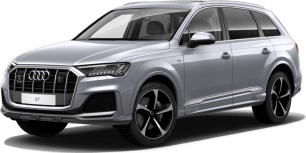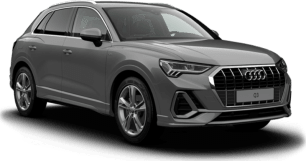Measuring 5063mm long, 1970mm wide and 1741mm tall in facelifted form, the Q7 is large for a large SUV, which goes some way to explaining why it's only available with seven seats.
That said, the third row is more of temporary solution than a permanent one, even for kids.
Granted I'm an adult that's 184cm tall, and therefore not the target audience here, it's still tight back there, albeit up with the best in class.
With the second slid all the way forward, I manage to have my knees pressed up against the seat backrest, while headroom is severely limited.
Footwell space is okay, and so too is toe-room. Again, children will cope, but only on shorter journeys.
Ingress and egress to the third row is made easier by the 40/20/40 split-fold middle bench, which can tumble forward easily with the pull of a tab and then a latch. It's not glamorous, but it's doable.
Conversely, the second row is spacious and easy to get in and out of, even when set up to make the rear occupants as comfortable as possible.
Behind our driving position, around 10cm of legroom is available, depending on the positioning of the bench. No matter what, though, there's plenty of toe-room, and two inches of headroom is on offer, despite the panoramic sunroof.
Indeed, this is one of very few SUVs that can accommodate three adults abreast in relative comfort, even with the transmission tunnel reducing footwell space.
For reference, top-tether and ISOFIX child-seat anchorage points are spread across the second and third rows.
Cargo capacity with the power-folding third row stowed is generous, at 865L, and can be expanded up to 2050L with the middle bench stowed. An undisclosed amount of space is available with all seven seats in use. Either way, it's more than enough for the weekly shop (as you can see in our pics).
The boot is made more useful thanks to the inclusion of four tie-down points and one side storage net, while the lack of a load lip makes dealing with bulkier items a lot easier.
The only real issue we had was where to store the load cover when not in use. There's no false floor to gobble it up, meaning it'll annoyingly live at home when you've got six or more people on board.
That's not to say the Q7 doesn't have other storage options; it's got plenty of them, such as the useful storage nets on the back of the front seat backrests.
The glove box is pleasingly large, although the central storage bin is not, with most of its space taken up by the wireless smartphone charger.
The door bins are simply massive, with the front items capable of accommodating a large bottle and two regular ones, while their rear siblings can take one of each.
Two cupholders are located between the driver and front passenger, while another pair is hidden in the middle row's fold-down armrest. Rear occupants are treated to two smaller items.
Connectivity-wise, in an old-school twist, four USB-A ports are split between the first and second rows. In both instances, a 12-volt power outlet is found nearby.
The former's input options are located in the central storage bin alongside SD and SIM card readers, while the latter's reside at the rear of the centre console, below the central air vents and climate controls.

